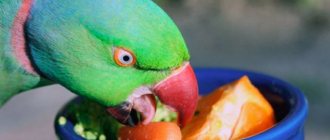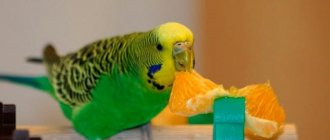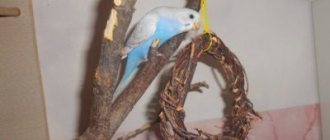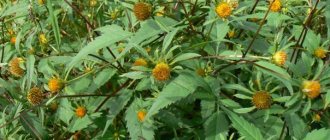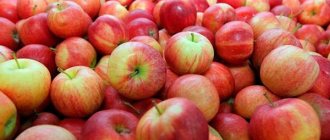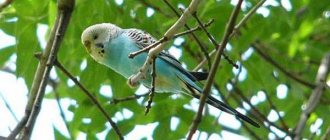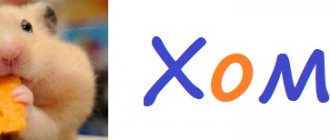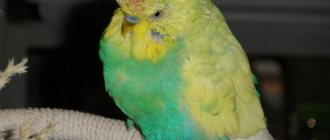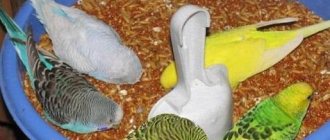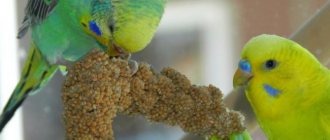- home
- Parrot
- Feeding
05/11/2019 The menu for a pet parrot should be balanced and varied - you should not feed the bird the same set of products. Not only fruits and vegetables, but also grains allow you to diversify your feathered pet’s diet. Millet is considered the most valuable for the bird's body. But is it possible to give parrots millet? As you know, this cereal is made from millet, but does this grain lose its beneficial properties during processing? Answers to frequently asked questions when creating a menu for a parrot are given in the article.
Can budgerigars eat millet?
Feeding millet to birds is not only prohibited, but also recommended. But, of course, when preparing a poultry’s diet, it is worth taking into account its personal taste preferences. If a budgerigar does not like millet or any other product, and he basically ignores it in the feeder, you should not force the bird to eat it. Products that the pet did not like, i.e. He doesn't eat them, so they should be excluded from the menu.
However, cases of a parrot refusing millet cereals are extremely rare. For a bird it is the same as millet. Therefore, you can feed parrots with this cereal according to the same scheme as millet.
Dry food must be present in a parrot's daily diet. The grain mixture should include 4-5 varieties of cereals, but the main component should be millet or millet. With an optimal ratio of proportions, the volume of millet or millet is 50-60% of the total mass of the mixture.
Cereal mealy feeds
Is it possible to use succulent foods as complementary foods? The diet of lovebirds should be complete. Parrots should not be given only one ready-made food. Birds may become bored with such food, and they will refuse to eat. To diversify the menu of lovebirds, it is recommended to include juicy food in the diet:
- grass;
- greenery;
- homemade fruits and vegetables.
Lemons. Every day you can give your parrots a small piece of citrus fruit along with the peel, sprinkled with sugar.
Greenery. Dill, aromatic parsley, salad greens, onions, and spinach contain vitamins that improve overall well-being, increase appetite and improve the functioning of the gastrointestinal tract.
Cucumbers. Lovebirds simply love to feast on fresh cucumbers.
Pears and green apples. Juicy fruits are necessary in the daily diet. You need to cut into slices and secure them among the rods.
Melon crops - juicy pumpkin, sugar melon, watermelon - are given along with the peel. Pumpkin seeds are especially beneficial.
Herbal flour. To prepare it, currant leaves, spring primrose leaves, fluffy clover, stinging nettle (young bushes) are collected, dried and ground into flour. Dosage – 3% of the main daily diet.
Young branches. They play an important role in the life of a bird: lovebirds use them to grind down their beaks.
In addition, the birds are given pieces of loaf soaked in milk, a boiled and finely chopped chicken egg, cherries, strawberries, and cottage cheese.
Oats are an easily digestible cereal that contains a number of amino acids that are not found in other grain crops. Oats contain 60% starch, 6% fat, 15% protein, phosphorus, calcium, sugar, and sodium. It is better to give birds not rolled oats, but feed oats, because whole grains contain more useful substances, and shelling helps to grind down the beak to a certain acceptable size.
Millet or millet with dehulled shell. Is it possible? The culture contains a lot of protein. The lovebird is given millet porridge with the addition of beets or carrots.
Millet is the main component of any feed. Due to a shortage of grain crops, the bird may get sick and die. The grain crop contains:
- phosphorus;
- vitamins;
- copper;
- amino acids.
To ensure optimal balance, multi-colored millet is included in equal proportions in the pet food they eat.
Corn contains carotene, minerals, vitamin K, amino acids. The grain has a hard shell, so the grain is first crushed and then fed to the birds. But young shoots of sprouted corn are considered more useful.
If you observe lovebirds, they spend almost all their time eating, constantly eating, but overeating should not be allowed.
What kind of millet should be
It is allowed to feed budgies only high quality millet. It is easy to distinguish good cereals from low-quality cereals by appearance.
The grains should be:
- Correct form, i.e. rounded;
- large size;
- pale yellow;
- glossy;
- sweetish in taste.
Only such millet cereals will benefit the parrot’s body. You should not give your pet cereal if its grains:
- Gray or dark shade;
- dull;
- have foreign impurities.
Is it possible to feed a parrot millet or buckwheat?
It is millet that should be given to the bird in dry form - it is advisable to feed the pet millet cereal only in the form of porridge or sprouted grains. Raw millet, peeled from husks, tends to oxidize, which affects its taste and healthiness. The parrot may well refuse such a product, and he will do the right thing.
As for buckwheat, it is also among the recommended healthy foods. It is better to give it to the parrot unrefined, as grain feed. On the eve of serving the bird, buckwheat is soaked and left overnight, then washed thoroughly and only then presented to the bird.
In addition, buckwheat can be given to your parrot in the form of porridge. Cook only with water or milk. It is important to prevent the cereal from boiling - the porridge should be crumbly. Boiled grains lose most of their usefulness and nutritional value.
The approximate daily dose of millet porridge, buckwheat, rice or any other is 21 g.
general information
Chumiza is an annual plant. Its growing area covers the territories of several Asian countries. The spread of this plant across the lands of hot Asian countries is associated with its characteristic feature. It is not afraid of arid climates and can survive for a long time without moisture, which compares favorably with most other varieties of grain crops.
The yield of this fodder crop is also usually several times higher than that of grain plants. As proof, it is worth giving the following example: one spikelet of chumiza can contain up to 6,000 grains. No other seed crop has such parameters.
The appearance of the plant is no less impressive than the given indicators. This is a two-meter bush formed by approximately 7 stems
Each of the stems is decorated with eye-catching wide leaves. The roots of the bush are a developed system and grow more than 1.5 m deep into the soil
It is noteworthy that this plant repels weeds. Even the ubiquitous loaches do not appear in areas where chumiza is grown.
Sprouted millet: benefits and harm for parrots
There are many beneficial aspects of a parrot’s consumption of millet cereals (especially in sprouted form). These include the following:
- Thanks to the high nutritional value and calorie content of the cereal, the growth and development of the bird is accelerated, the parrot's immunity is strengthened and overall health improves.
- Thanks to the iron, zinc and amino acids contained in millet, the appearance of the bird improves - the plumage becomes bright and thick.
- The functioning of the gastrointestinal tract improves.
In addition to the already mentioned substances contained in millet, this cereal is rich in:
- Belkom;
- vitamin B;
- vitamin E;
- calcium;
- magnesium;
- macroelements;
- microelements;
- phosphorus.
But with all the extensive positive properties, this product is not without negative influence. If the product is prepared incorrectly, it causes digestive problems and disruptions to the gastrointestinal tract. If stored incorrectly, it will become bitter and the bird will not eat it. Overeating millet cereals in any form is fraught with the bird gaining excess weight.
In addition to sprouted millet, it is recommended to include sprouted wheat in the bird’s menu - it is also beneficial for the bird’s body.
Sprouted cereals should be supplemented with the main food. This feeding is especially important in the spring and winter seasons - it will compensate for the lack of vitamins and other essential substances in the pet’s body. Despite its great benefits, sprouted millet is a difficult product for birds to digest. Therefore, its maximum permissible daily dose is 2.5 g.
What types of millet cereals are suitable for poultry diet?
Of all the possible types of millet cereal (in industrial processing), only three are beneficial for birds. The following types of cereals are recommended and allowed for consumption:
- Sanded (films and shells are completely removed from the grains);
- peeled (an alternative name is dranets; the grains are stripped of only the shell);
- crushed (grains are crushed).
The polished look is the least useful. During processing, the grains lose most of their properties. Simply refined grains retain more nutrients, but are still inferior in usefulness to crushed cereals. Crushed cereals are the healthiest. It is used to prepare liquid porridges. This food is suitable even for birds with diseased digestive organs.
How to cook millet for a parrot
Millet is served to the parrot in the form of porridge. To prepare it correctly, you need:
- Rinse the cereal.
- Pour boiling water over the grains and leave them there for 10 minutes.
- Cook until crumbly.
If you need the product urgently, you can prepare it in a simpler and faster way - just soak the cereal in boiling water and wait 15-20 minutes.
Preparing sprouted grains is also very easy. To get a healthy fresh product, you need:
- Rinse the cereal.
- Soak the grains in warm water and leave for half a day (an alternative is to soak in cold water and leave for 15 hours).
- Rinse the cereal again.
- Spread cheesecloth on a flat plate.
- It is advisable to place the grains on gauze in one layer (maximum thickness – 20 mm).
- Place the plate in a well-lit place with a warm atmosphere and leave it there for a week.
After 7 days, the cereal will germinate. It is better to give the bird sprouts 6 mm long - the benefits of such sprouts are maximum, they are a kind of vitamin concentrate.
Can You Give a Parrot Tea?
WHAT CAN BE HARMFUL AND DANGEROUS FOR A BUDGY PARROT.
STICKS WITH HONEY. This is a treat for parrots. But with individual tolerance or food intolerance, the parrot can relax. In addition, you run the risk of buying a low-quality product: we had a case where we found dirt on the base of the stick. It is dangerous to feed birds cabbage, dill, parsley, lettuce and some other vegetables and herbs, which often contain nitrates or alkaloids. HUMAN FOOD IS NOT SUITABLE for a budgie and will shorten its life.
[]You should not give parrots:
* Mango is toxic to birds; * papaya, persimmon, avocado, potatoes, parsley and other herbs (they contain a lot of essential substances that are harmful to budgies), as well as vegetables from soup or stew that contain a large amount of salt and fat are harmful.
Many fruit pits (cherry, plum, apricot, etc.) contain hydrocyanic acid, which can cause poultry poisoning. * Candied fruits should not be given. * Cheese should not be given. Dairy products in themselves are harmful to the parrot, but the exception is low-fat cottage cheese, although there is an opinion that this too should not be given.
[]What can/should be given:
SPROUTED OR SOAKED OATS or WHEAT Pay attention to whether the oats turn black when soaked or, even worse, whether dirt appears. It’s better not to give such oats
If you store sprouted oats (wheat) in the refrigerator, they will not germinate. If you leave it in a dry place to germinate, make sure it doesn’t turn sour.
PORRIDGE. Consult your veterinarian about what is best for your pet: maybe rice porridge, maybe buckwheat, and how this may affect your pet’s digestion. We eat buckwheat. The porridge can either be cooked a little or steamed in a thermos without adding salt.
FRUITS AND VEGETABLES. The most favorite delicacy of budgies is a carrot and a leaf of lettuce, an apple. If you are going to feed grapes or cherries, pay attention! a budgie may be frightened by the dark color and will not eat. Grapes that are green but sweet may work. Sour grapes or an unripe apple can make a bird relax. It is advisable to give a little fruits, greens and vegetables, literally just a few bites to begin with, because they can weaken a little (there may be liquid droppings - this is due to individual food tolerance). In winter, citrus fruits containing vitamin C are especially useful. A small piece of banana.
BOILED EGG AND GRATED SHELL. It is necessary to include budgies in the diet; if possible, give a quail egg with or without grated shell, if there is mineral supplementation. In normal times, it is given 1-2 times a week. During the mating season, it is advisable to give every day, before laying begins. Eggs are excluded from the diet until the first chick appears. The egg is excluded for this time so that there are not a large number of empty eggs in the clutch and so that the female’s instinct to break the egg in the clutch does not work. Therefore, after the appearance of the first chick, the egg is gradually introduced into the diet. White and yolk, grated shell are needed for the normal development of chicks and maintaining the body of the parents who feed them. However, you cannot feed the chicks with a mixture containing protein, only yolk. The chicken egg shell, crushed into powder, is pre-calcined in the oven to avoid infection with infectious diseases (put the egg shells in a fireproof container and place in a preheated oven for about 15-20 minutes - this will remove the remaining protein and yolk and disinfect the shell).
We recommend reading: What Makes a Kitten Drool []Herbs that can be given to budgies:
grapevine Fruits of yellow acacia Leaves and flowers of clover Nettle – nettle can be served to budgerigars in several forms – firstly, scalded with boiling water; secondly – frozen; thirdly – dried. And only in one of these options, not in any other. Larch needles Leaves and flowers of coltsfoot Carrot tops Oats Dandelions – budgerigars love dandelions very much, and this is the most common plant that is included in the diet of almost every parrot in the summer
You can give your parrot leaves, flowers, rhizomes Plantain Millet - some parrots love millet very much, so pay special attention to it
